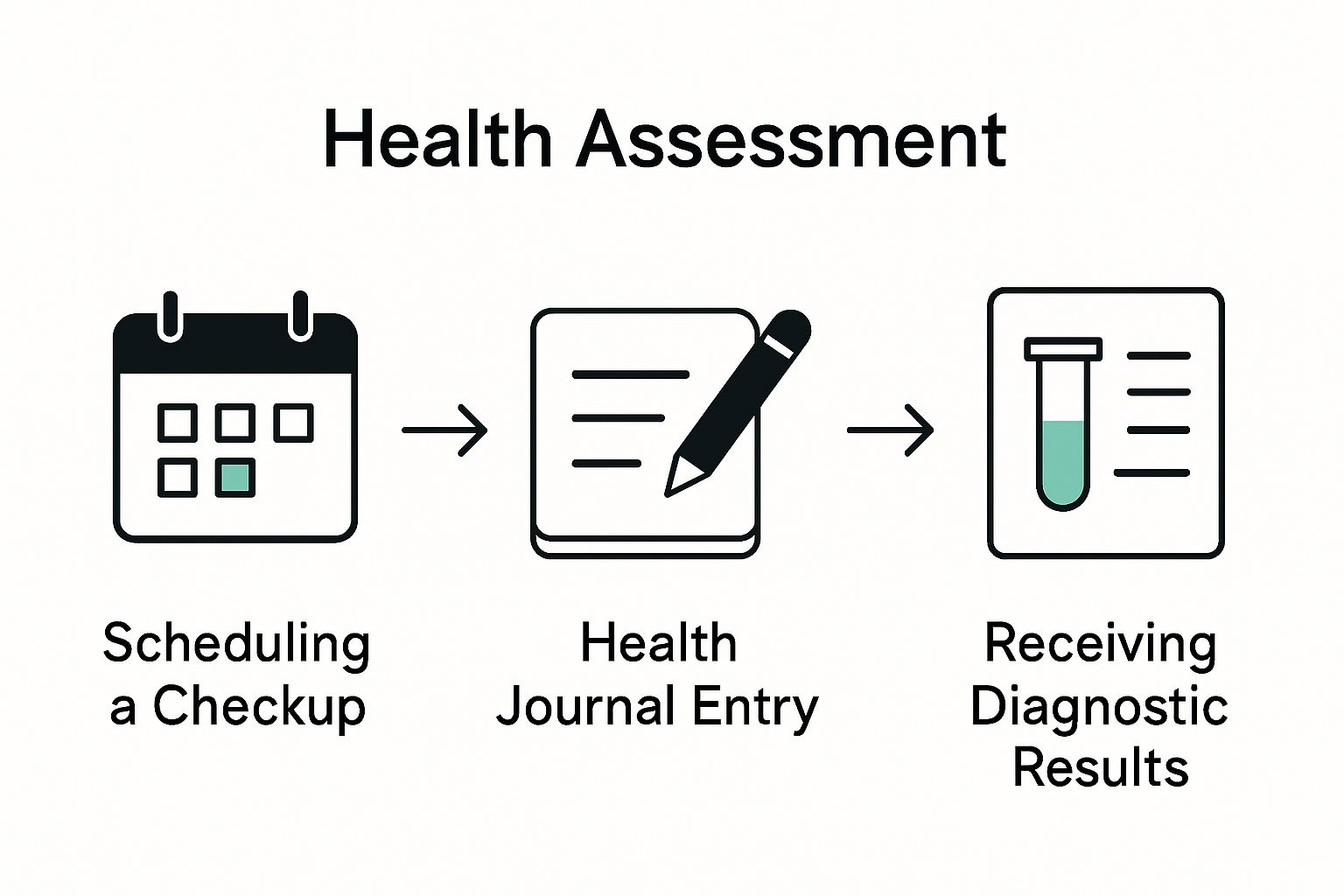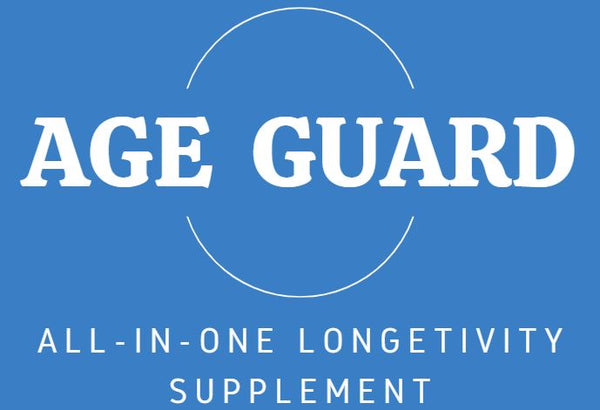
How to Maintain Vitality for Longevity and Wellness
Share
Everyone wants to feel younger and stay healthier for longer, but most people do not realize how much impact their daily habits have on their vitality. You might think small changes only make a tiny difference, yet research shows that getting just 7-9 hours of high-quality sleep each night can dramatically improve everything from mood to cellular health. So the true secret to natural antiaging is not about expensive treatments or miracle supplements. It is about mastering a few simple steps that anyone can start today.
Table of Contents
- Step 1: Assess Your Current Health Status
- Step 2: Establish A Balanced Nutrition Plan
- Step 3: Incorporate Regular Physical Activity
- Step 4: Prioritize Quality Sleep And Rest
- Step 5: Integrate Stress Management Techniques
Quick Summary
| Key Point | Explanation |
|---|---|
| 1. Schedule a comprehensive health checkup | A complete medical assessment helps identify current health status and risks for better wellness strategies. |
| 2. Document your current dietary habits | Tracking food intake for a week reveals nutritional patterns needing improvement and guides a balanced nutrition plan. |
| 3. Create a personalized exercise plan | Develop a progressive approach that includes cardiovascular, strength, and flexibility exercises based on your fitness level. |
| 4. Establish a structured sleep routine | Regular sleeping hours and sleep-friendly environments significantly enhance sleep quality and support overall health. |
| 5. Develop a stress management toolkit | Employ techniques like meditation and setting boundaries to mitigate stress and improve emotional resilience over time. |
Step 1: Assess Your Current Health Status
Understanding your current health status is the critical foundation for any successful vitality and wellness journey. This initial assessment provides a comprehensive snapshot of your physical, mental, and metabolic health, allowing you to create a targeted strategy for maintaining and improving your overall well-being.
Begin by scheduling a comprehensive medical checkup with your primary healthcare provider. During this evaluation, request a full panel of diagnostic tests that go beyond standard screenings. These should include comprehensive blood work analyzing key markers such as hormonal levels, inflammation indicators, metabolic function, nutrient deficiencies, and cellular health markers. Research from the National Institutes of Health highlights that self-rated health assessments combined with clinical diagnostics offer powerful insights into potential health risks and optimization opportunities.
While medical tests provide objective data, your personal health perception matters equally. Conduct a thorough self-assessment by carefully documenting your current energy levels, sleep quality, stress responses, physical fitness, and any recurring symptoms or discomforts. Pay special attention to subtle changes in your body that might indicate underlying health shifts. Create a detailed health journal tracking these observations, which will serve as a valuable reference point for monitoring your vitality improvement progress.
Consider incorporating advanced diagnostic tools like at-home testing kits for more nuanced insights. These may include genetic testing, microbiome analysis, or comprehensive metabolic panels that provide deeper understanding of your unique physiological landscape. Genetic screenings, in particular, can reveal predispositions to certain age-related conditions and metabolic tendencies, enabling more personalized intervention strategies.
To verify the completeness of your health assessment, ensure you have gathered the following key information:
Below is a checklist summarizing essential information to verify when assessing your current health status for vitality and longevity.
| Item | Description | Purpose |
|---|---|---|
| Comprehensive blood test results | Covers metabolic, hormonal, and inflammatory markers | Identify physiological imbalances |
| Personal health history & symptom log | Detailed documentation of current and past symptoms | Detect recurring or subtle health issues |
| Professional medical evaluation | Assessment and initial medical recommendations | Gain expert insights and next steps |
| Advanced diagnostic test results (optional) | Genetic, microbiome, or extended metabolic tests | Reveal deeper or personalized risk factors |
| Self-assessment journal | Records energy, sleep, stress, physical fitness observations | Track subjective health and improvement |
| Initial lifestyle recommendations | Suggestions from your provider based on assessment outcomes | Provide actionable starting strategies |

- Comprehensive blood test results covering metabolic, hormonal, and inflammatory markers
- Detailed personal health history and current symptom documentation
- Professional medical evaluation and initial recommendations
- Optional advanced diagnostic test results
By meticulously completing this initial assessment, you establish a solid baseline for your vitality optimization journey. Learn more about natural antiaging strategies that can complement your personalized health approach.
Step 2: Establish a Balanced Nutrition Plan
Building a balanced nutrition plan serves as the cornerstone of maintaining vitality and supporting long-term wellness. This crucial step transforms your dietary approach from random consumption to intentional nourishment, directly impacting cellular health, energy levels, and overall longevity.
Research from the Harvard School of Public Health emphasizes that a strategic nutrition plan goes beyond simple calorie counting. Your goal is to create a comprehensive eating strategy that provides optimal nutrient density, supports metabolic function, and counteracts age-related cellular degradation.
Start by conducting a thorough inventory of your current eating habits. Document everything you consume for one full week, noting not just quantities but also nutritional quality. Look for patterns of processed food consumption, sugar intake, and potential nutrient gaps. This honest self-assessment allows you to identify specific areas requiring nutritional refinement.
Design your balanced nutrition plan around whole, nutrient-rich foods that provide maximum cellular support. Focus on incorporating diverse protein sources like wild-caught fish, lean poultry, plant-based proteins, and occasional grass-fed meats. Emphasize complex carbohydrates from vegetables, legumes, and whole grains while minimizing refined sugars and processed carbohydrates. Include healthy fats from sources like avocados, nuts, seeds, and olive oil to support hormonal balance and reduce inflammation.
Consider working with a registered nutritionist who can provide personalized guidance tailored to your specific health assessment from the previous step. They can help you develop a customized meal plan that addresses your unique metabolic needs, potential nutrient deficiencies, and wellness objectives.
To verify the effectiveness of your nutrition plan, track these key indicators:
This table summarizes key indicators to monitor when evaluating the effectiveness of your balanced nutrition plan for vitality and long-term wellness.
| Indicator | What to Look For | Significance |
|---|---|---|
| Daytime energy levels | Consistent energy, less fatigue | Stable fuel supply to body & brain |
| Digestion and gut health | Comfortable digestion, regularity | Nutrient absorption and immunity |
| Weight stability | No extreme fluctuations | Healthy metabolism, body balance |
| Inflammation markers | Decrease or stability | Reduced risk of chronic illness |
| Mental clarity | Consistent focus, clear thinking | Dietary impact on cognitive health |
- Consistent energy levels throughout the day
- Improved digestion and gut health
- Stable weight without extreme fluctuations
- Reduced inflammation markers
- Enhanced mental clarity
Remember that nutrition is not about perfection but consistent, mindful choices.
 Explore our comprehensive meal planning strategies to further refine your approach to eating for vitality.
Explore our comprehensive meal planning strategies to further refine your approach to eating for vitality.
Step 3: Incorporate Regular Physical Activity
Physical activity represents a powerful cornerstone in maintaining vitality and promoting long-term wellness. This step transforms movement from an optional activity to a fundamental pillar of your health optimization strategy, targeting cellular rejuvenation, metabolic efficiency, and overall physiological resilience.
Research from the Centers for Disease Control and Prevention consistently demonstrates that regular physical activity significantly reduces risks of chronic diseases and supports optimal aging processes. Your goal is to design a comprehensive movement plan that integrates diverse exercise modalities tailored to your current fitness level and health assessment.
Begin by conducting an honest self-evaluation of your current physical capabilities. This means understanding your baseline strength, flexibility, cardiovascular endurance, and any potential limitations from previous health assessments. Develop a progressive exercise strategy that starts gently and incrementally challenges your body. For those with limited prior exercise experience, start with low-impact activities like walking, swimming, or gentle yoga that build foundational fitness without overwhelming your system.
Structure your physical activity plan to include three critical components: cardiovascular exercise, strength training, and flexibility work. Cardiovascular activities like brisk walking, cycling, or dancing improve heart health and metabolic function. Strength training using bodyweight exercises, resistance bands, or light weights helps maintain muscle mass and bone density. Flexibility work through stretching or practices like yoga supports joint health and prevents age-related mobility restrictions.
Consider working with a certified fitness professional who can design a personalized program accounting for your unique health profile. They can help you establish safe progression protocols, correct potential movement imbalances, and provide technical guidance on proper exercise techniques that minimize injury risks.
To verify the effectiveness of your physical activity plan, track these key indicators:
- Improved resting heart rate
- Increased energy levels throughout the day
- Enhanced muscle tone and strength
- Better sleep quality
- Reduced stress and improved mood
Remember that consistency matters more than intensity. Start small, build gradually, and listen to your body’s signals. Learn more about integrating movement into your wellness routine to support your long-term vitality goals.
Step 4: Prioritize Quality Sleep and Rest
Sleep represents a critical yet often overlooked pillar of vitality and wellness, serving as the body’s primary regeneration and repair mechanism. This step transforms your approach to rest from a passive experience to an active strategy for cellular rejuvenation and overall health optimization.
Research from the Sleep Foundation reveals that consistent, high-quality sleep is fundamental to maintaining long-term physiological and cognitive health. Your goal is to design a comprehensive sleep strategy that supports deep, restorative rest and addresses potential barriers to optimal sleep quality.
Begin by creating a structured sleep environment that signals to your body it is time to rest. This means systematically eliminating potential disruptions and designing a bedroom that promotes relaxation. Invest in a high-quality mattress that supports proper spinal alignment, use blackout curtains to minimize light exposure, and maintain a consistent room temperature between 60-67 degrees Fahrenheit. Remove electronic devices that emit blue light and create potential mental stimulation before bedtime.
Establish a consistent sleep-wake cycle by setting fixed bedtime and wake-up times, even on weekends. This helps regulate your body’s internal circadian rhythm, improving both the quality and duration of your sleep. Develop a pre-sleep ritual that signals to your body it is time to wind down. This might include gentle stretching, reading a physical book, practicing meditation, or engaging in light breathing exercises that transition your nervous system from an active state to a relaxed one.
Address potential sleep disruptors by examining your daily habits. Reduce caffeine intake after 2 PM, limit alcohol consumption, and create a clear boundary between work and personal time. Consider using natural sleep support supplements like magnesium or melatonin, but consult with a healthcare professional to ensure they align with your individual health profile.
To verify the effectiveness of your sleep optimization strategy, track these key indicators:
Here is a checklist to help you confirm successful implementation and continuous improvement of your sleep optimization strategy.
| Key Indicator | What to Monitor | Why It Matters |
|---|---|---|
| Sleep duration | 7-9 hours per night | Supports cellular repair & function |
| Time to fall asleep | Reduction over time | Indicates restful bedtime routine |
| Nighttime awakenings | Fewer interruptions | Reflects deeper, restorative sleep |
| Morning energy | Increased alertness & stamina | Sign of effective sleep cycle |
| Mood & cognitive clarity | Improved daily functioning | Sensitive to sleep quality |
- Consistent sleep duration of 7-9 hours nightly
- Reduced time needed to fall asleep
- Fewer nighttime awakenings
- Increased morning energy levels
- Improved mood and cognitive clarity
Remember that sleep is a skill that can be developed and refined over time. Explore our comprehensive guide to natural antiaging strategies to further enhance your wellness journey.
Step 5: Integrate Stress Management Techniques
Stress management is not merely a luxury but a critical component of maintaining vitality and long-term wellness. Chronic stress acts as a silent accelerator of cellular aging, disrupting hormonal balance, compromising immune function, and potentially undermining the positive progress made in previous steps of your wellness journey.
Research from the National Institutes of Health demonstrates that strategic mind-body interventions can significantly mitigate stress’s detrimental physiological impacts. Your goal is to develop a comprehensive stress management approach that addresses both immediate emotional responses and long-term physiological resilience.
Begin by conducting a thorough stress audit of your daily life. Document recurring stressors, emotional triggers, and physiological responses. This means tracking not just external pressures but also your internal reactions. Recognize patterns of tension, identify specific situations that provoke anxiety, and understand how stress manifests in your body through symptoms like muscle tightness, digestive issues, or disrupted sleep.
Design a multifaceted stress management toolkit that incorporates diverse techniques targeting different aspects of your stress response.
Below is a table summarizing the main techniques and boundaries to include in your stress management toolkit for better vitality and resilience.
| Technique/Strategy | Application | Benefit |
|---|---|---|
| Daily meditation | Start with 5-10 minutes, increase gradually | Promotes calm, regulates stress hormones |
| Breathing exercises | Box breathing or diaphragmatic anytime | Rapid calming of nervous system |
| Mindfulness practices (yoga, tai chi) | Incorporate several times weekly | Combines physical and mental relaxation |
| Work/personal life boundaries | Transition rituals, dedicated times | Prevents chronic stress accumulation |
| Emotional support network | Reach out to friends, family, professionals | Provides perspective and processing support |
Establish clear boundaries between work and personal life to prevent chronic stress accumulation. This might involve creating dedicated transition rituals, such as a short walk after work, a mindful breathing session, or journaling to process daily experiences. Develop a support network of friends, family, or professional counselors who can provide emotional guidance during challenging periods.
To verify the effectiveness of your stress management strategy, track these key indicators:
- Reduced resting heart rate
- More stable emotional responses
- Improved sleep quality
- Enhanced ability to handle unexpected challenges
- Increased overall sense of calm and emotional resilience
Remember that stress management is a skill developed through consistent practice and self-compassion. Explore our guide to natural antiaging strategies to further support your holistic wellness journey.
Ready to Take Your Longevity Journey Further?
You work hard to assess your health, refine your nutrition, exercise regularly, and manage your stress, but sustaining vitality in the long run can still feel overwhelming. Many people following steps like those in this article face a frustrating barrier: despite best efforts, it can be hard to maintain consistent cellular health, energy, and resilient aging. When your goal is lasting wellness, gaps in your daily regimen or missing support for your body’s deepest processes may pull you off track. Building a strong foundation is essential—yet most routines need targeted support for true anti-aging results. You deserve a solution that works with your whole-body approach.
Discover Age Guard Anti-Aging Solutions

Ready to amplify your results and move from intention to action? Age Guard’s supplement combines NMN, collagen, spermidine, and powerful antioxidants in precise, research-backed dosages, designed to work alongside the daily wellness habits you are building. Explore real user stories, ingredient science, and trust-backed guarantees at MyAgeGuard.com. Take action now—visit the Anti-Aging Supplement collection and see how Age Guard can help you maintain your vitality every single day.
Frequently Asked Questions
What steps can I take to assess my current health status?
Begin by scheduling a comprehensive medical checkup with your healthcare provider that includes a full panel of diagnostic tests. Additionally, perform a self-assessment by documenting your energy levels, sleep quality, stress responses, physical fitness, and any recurring symptoms.
How can I create a balanced nutrition plan to support my wellness?
Start by tracking your eating habits for one week to identify patterns. Focus on incorporating whole, nutrient-rich foods and minimizing processed foods and sugars. Working with a registered nutritionist can also help tailor a meal plan to your specific needs.
What types of physical activity should I include in my routine for optimal health?
Your routine should include cardiovascular exercises, strength training, and flexibility work. Aim for a mix of activities like walking, swimming, weight training, and yoga to improve heart health, maintain muscle mass, and enhance joint flexibility.
How can I improve my sleep quality effectively?
Create a structured sleep environment by eliminating disturbances that hinder rest. Maintain a consistent sleep-wake cycle, develop a calming pre-sleep ritual, and address daily habits that disrupt sleep, such as limiting caffeine and screen time before bed.
